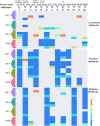Understanding the Mechanisms Behind the Response to Environmental Perturbation in Microbial Mats: A Metagenomic-Network Based Approach
- PMID: 30555424
- PMCID: PMC6280815
- DOI: 10.3389/fmicb.2018.02606
Understanding the Mechanisms Behind the Response to Environmental Perturbation in Microbial Mats: A Metagenomic-Network Based Approach
Abstract
To date, it remains unclear how anthropogenic perturbations influence the dynamics of microbial communities, what general patterns arise in response to disturbance, and whether it is possible to predict them. Here, we suggest the use of microbial mats as a model of study to reveal patterns that can illuminate the ecological processes underlying microbial dynamics in response to stress. We traced the responses to anthropogenic perturbation caused by water depletion in microbial mats from Cuatro Cienegas Basin (CCB), Mexico, by using a time-series spatially resolved analysis in a novel combination of three computational approaches. First, we implemented MEBS (Multi-genomic Entropy-Based Score) to evaluate the dynamics of major biogeochemical cycles across spatio-temporal scales with a single informative value. Second, we used robust Time Series-Ecological Networks (TS-ENs) to evaluate the total percentage of interactions at different taxonomic levels. Lastly, we utilized network motifs to characterize specific interaction patterns. Our results indicate that microbial mats from CCB contain an enormous taxonomic diversity with at least 100 phyla, mainly represented by members of the rare biosphere (RB). Statistical ecological analyses point out a clear involvement of anaerobic guilds related to sulfur and methane cycles during wet versus dry conditions, where we find an increase in fungi, photosynthetic, and halotolerant taxa. TS-ENs indicate that in wet conditions, there was an equilibrium between cooperation and competition (positive and negative relationships, respectively), while under dry conditions there is an over-representation of negative relationships. Furthermore, most of the keystone taxa of the TS-ENs at family level are members of the RB and the microbial mat core highlighting their crucial role within the community. Our results indicate that microbial mats are more robust to perturbation due to redundant functions that are likely shared among community members in the highly connected TS-ENs with density values close to one (≈0.9). Finally, we provide evidence that suggests that a large taxonomic diversity where all community members interact with each other (low modularity), the presence of permanent of low-abundant taxa, and an increase in competition can be potential buffers against environmental disturbance in microbial mats.
Keywords: MEBS; environmental perturbation; microbial mats; network motifs; rare biosphere; time series ecological networks.
Figures








Similar articles
-
A Metagenomic Time-Series Approach to Assess the Ecological Stability of Microbial Mats in a Seasonally Fluctuating Environment.Microb Ecol. 2023 Nov;86(4):2252-2270. doi: 10.1007/s00248-023-02231-9. Epub 2023 Jul 2. Microb Ecol. 2023. PMID: 37393557 Free PMC article.
-
Comparative metagenomics of two microbial mats at Cuatro Ciénegas Basin II: community structure and composition in oligotrophic environments.Astrobiology. 2012 Jul;12(7):659-73. doi: 10.1089/ast.2011.0724. Astrobiology. 2012. PMID: 22920516 Free PMC article.
-
Metagenomic insight into taxonomic composition, environmental filtering and functional redundancy for shaping worldwide modern non-lithifying microbial mats.PeerJ. 2024 May 30;12:e17412. doi: 10.7717/peerj.17412. eCollection 2024. PeerJ. 2024. PMID: 38827283 Free PMC article.
-
The Rare Biosphere: This report is based on a colloquium convened by the American Academy of Microbiology on April 27–29, 2009 in San Francisco, CA.Washington (DC): American Society for Microbiology; 2011. Washington (DC): American Society for Microbiology; 2011. PMID: 32809309 Free Books & Documents. Review.
-
Iron Flocs and the Three Domains: Microbial Interactions in Freshwater Iron Mats.mBio. 2020 Dec 15;11(6):e02720-20. doi: 10.1128/mBio.02720-20. mBio. 2020. PMID: 33323508 Free PMC article. Review.
Cited by
-
Evolutionary Rescue of an Environmental Pseudomonas otitidis in Response to Anthropogenic Perturbation.Front Microbiol. 2021 Jan 18;11:563885. doi: 10.3389/fmicb.2020.563885. eCollection 2020. Front Microbiol. 2021. PMID: 33552002 Free PMC article.
-
A survey of computational approaches for characterizing microbial interactions in microbial mats.Genome Biol. 2025 Jun 16;26(1):168. doi: 10.1186/s13059-025-03634-2. Genome Biol. 2025. PMID: 40524188 Free PMC article. Review.
-
Population genomics of Vibrionaceae isolated from an endangered oasis reveals local adaptation after an environmental perturbation.BMC Genomics. 2020 Jun 22;21(1):418. doi: 10.1186/s12864-020-06829-y. BMC Genomics. 2020. PMID: 32571204 Free PMC article.
-
The lost world of Cuatro Ciénegas Basin, a relictual bacterial niche in a desert oasis.Elife. 2018 Nov 20;7:e38278. doi: 10.7554/eLife.38278. Elife. 2018. PMID: 30457104 Free PMC article.
-
Species-specific responses of marine bacteria to environmental perturbation.ISME Commun. 2023 Sep 22;3(1):99. doi: 10.1038/s43705-023-00310-z. ISME Commun. 2023. PMID: 37736763 Free PMC article.
References
-
- Andrews S. (2010). FastQC: A Quality Control Tool for High Throughput Sequence Data. Available at: http://www.bioinformatics.babraham.ac.uk/projects/fastqc
-
- Baiser B., Elhesha R., Kahveci T. (2016). Motifs in the assembly of food web networks. Oikos 125 480–491. 10.1111/oik.02532 - DOI
LinkOut - more resources
Full Text Sources

